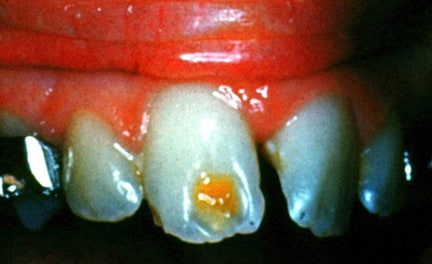

Department of Pediatric Dentistry
Resident’s Name: Murphy Program:Lutheran Medical Center - Providence
Article title: Intrusion Injuries of Primary Incisors Part II: Sequelae affecting the intruded Primary Incisors
Author(s): Mai Diab DDS MSc, Hossam Elbadrawy DDS MS
Journal: Quintessence International
Year. Volume (number). Page #’s: 2000. 31 #5. 335-341
Major topic: Intrusion Injuries and their follow up schedule/complications
Minor topic(s): Issues arising from intrusions
Main Purpose: Review Intrusion injuries
Overview of method of research: Clinical Review
Findings:
An intrusion injury occurs when a severe impact displaces the affected incisor deeper into the alveolar bone along the axis of the tooth causing trauma to the pulp and periodontal tissue. Intrusion injuries occur rather frequently in young children. Management of the injury depends on the extent of the intrusion and if there is an alveolar bone fracture. Radiographic exam must be completed to note the closeness of the developing tooth bud, alveolar bone fracture, and the amount of PDL that has diminished or eliminated.
The possible outcome of an intrusion injury is variable. The tooth may re-erupt with no complications, color changes may occur(gray, red, pinkish, bluish, black, or yellow), pulpal necrosis, resorption, or become anklosed.
Red/Gray Discoloration
Usually noticeable shortly after the injury. The gray color is caused by the traumatized pulp/tissue leaking heme into the dental tubules. This change in color may be reversible if the pulp survives the injury. Proper follow up is necessary. Some believe that a persistant gray color does NOT necessarily mean the pulp has necrosed, while others disagree. Frequent follow up appointments to monitor the tooth, and a good history from the patient will determine the necessary tx. If there is no pain or sensitivity, and no radiographic pathology, it’s ok to continue to monitor the tooth. If there is pain, etc, pulpectomy or EXT is indicated.
Yellow Teeth
This signifies calcification/obliteration of the pulpal canal. These should be treated the same as gray teeth, monitor it and treat any pertinent issues accordingly.
Necrosis
Loss of vitality is a common complication with intrusion injuries. The severity of the injury and the age of the child play in role in which way the pulp will react. More serious intrusions(bone fractures, >50% of the crown intruded) usually necrosis more often, and younger children (2-3) tend to show less necrosis than older children do. Tx options vary. Some suggest performing pulpectomies to try to save the tooth. Other disagree, stating that over instrumentation could cause injury to the developing tooth bud, and that the probability of ankylosis warrant EXT.
Abscess
Abscesses may occur with intruded teeth. If an abscess forms, EXT the tooth ASAP.
Ankylosis
Ankylosis is a real complication. Frequent recall exams to monitor if the tooth is in fact coming down is very important. If ankylosis is suspected with clinical exam(dull percussion, no reerupting), and a nonexistant PDL radiographically, take the tooth out ASAP.
Key points/Summary:
1. A proper exam at the time of injury is of great importance.
2. Frequent recall exams to assess how the tooth is doing must be done at 1-2 weeks, monthly for the first 3 months, and then every six months.
4. Monitoring the tooth is acceptable
5. Possible treatment includes doing nothing, performing a pulpectotmy, and EXT
6. Remember… the MOST important thing is the permanent tooth bud. If it’s in any danger, or may have been injured, try to get the primary tooth out ASAP.
Assessment of Article:
Great article. Every provider is going to differ on how they choose to treat intrusion injuries, and more often than not, they both may be correct.
No comments:
Post a Comment